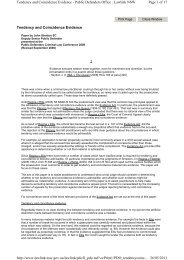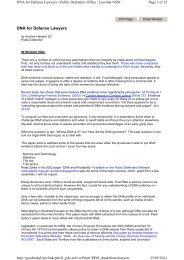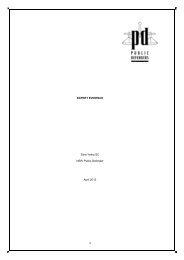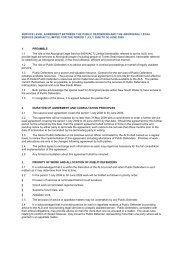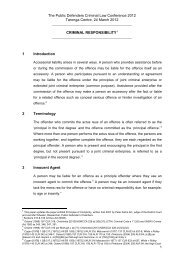Right to Silence: inferences from silence - The Public Defenders
Right to Silence: inferences from silence - The Public Defenders
Right to Silence: inferences from silence - The Public Defenders
You also want an ePaper? Increase the reach of your titles
YUMPU automatically turns print PDFs into web optimized ePapers that Google loves.
13. In the latter case Lord Mustill (with whom the rest of the Appellate Committee<br />
agreed) said at p 40,<br />
“That there is strong presumption against interpreting the statute as taking<br />
away the right of <strong>silence</strong>, at least in some of its forms, cannot in my view be<br />
doubted. Recently, Lord Griffiths (delivering the opinion in the Privy Council<br />
in Lam Chi-ming v <strong>The</strong> Queen [1991] 2 AC 212, 222) described the privilege<br />
against self incrimination as ‘deep rooted in English law,’ and I would not<br />
wish <strong>to</strong> minimise its importance in any way.<br />
Nevertheless it is clear that statu<strong>to</strong>ry interference with the right is almost as<br />
old as the right itself. Since the 16 th century legislation has established an<br />
inquisi<strong>to</strong>rial form of investigation in<strong>to</strong> the dealings and assets of bankrupts<br />
which is calculated <strong>to</strong> yield potentially incriminating material, and in more<br />
recent times there have been many other examples, in widely separated<br />
fields, which are probably more numerous than is generally appreciated.<br />
<strong>The</strong>se statutes differ widely as <strong>to</strong> their aims and methods. In the first place,<br />
the ways in which the overriding of the immunity is conveyed are not the<br />
same. Sometimes it is made explicit. More commonly, it is left <strong>to</strong> be inferred<br />
<strong>from</strong> general language which contains no qualification in favour of the<br />
immunity.<br />
Secondly, there are variations in the effect on the admissibility of information<br />
obtained as a result of the investigation. <strong>The</strong> statute occasionally provides in<br />
so many terms that the information may be used in evidence; sometimes<br />
that it may<br />
not be used for certain purposes, inferentially permitting its use for others; or<br />
it may be expressly prescribed that the evidence is not <strong>to</strong> be admitted; or<br />
again, the statute may be silent.”<br />
Since then Parliament has (by section 59 of and Schedule 3 <strong>to</strong> the Youth Justice and<br />
Criminal Evidence Act 1999) amended a considerable number of different statu<strong>to</strong>ry<br />
provisions of this type so as <strong>to</strong> introduce a prohibition on material disclosed under<br />
compulsion being used in evidence in criminal proceedings. This was no doubt in<br />
anticipation of the coming in<strong>to</strong> force of the Human <strong>Right</strong>s Act 1998.<br />
14. I have some reservations as <strong>to</strong> whether the existence of a “balancing” provision of<br />
this sort alters the need for clear words if the privilege is <strong>to</strong> be removed or curtailed.<br />
As Moore-Bick LJ acknowledged, there is not a perfect balance; material disclosed<br />
under compulsion may point <strong>to</strong> a line of inquiry producing evidence which is<br />
admissible in criminal proceedings, <strong>to</strong> the detriment of the accused. But I respectfully<br />
agree with Lord Neuberger that in a case where Parliament has left no room for<br />
doubt that it intends the privilege <strong>to</strong> be withdrawn, there is no need for the Court <strong>to</strong><br />
lean in favour of the narrowest possible construction of the reach of the relevant<br />
provision. As already noted, an important part of the legislative purpose of these<br />
provisions is <strong>to</strong> reduce the risk of injustice <strong>to</strong> victims of crime, and that purpose might<br />
be frustrated by an excessively narrow approach<br />
Colin Wells July 2013 Page 22



